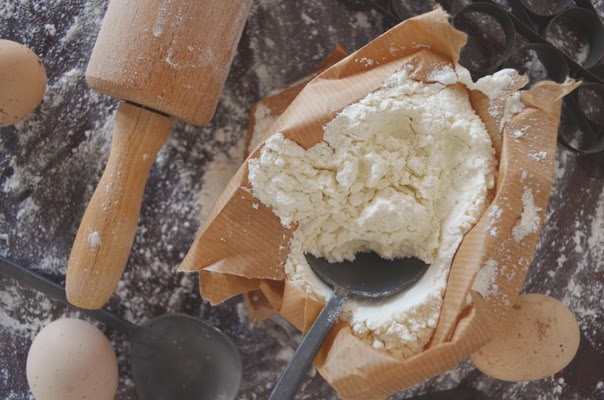Self-raising flour - Make it yourself!
Self-raising flour, also called self-rising flour, is an all-purpose flour with a leavening agent, and occasionally salt, blended into it. It was created to make life easier for bakers. Rising agents are already added to the flour, so you could skip the parts with measuring flour and baking powder, sifting them and blending them together thoroughly. Super handy.
So why would you need a substitute?
Apart from not having it at home when you find a recipe that calls for it, some people choose not to buy it at all. Self-raising flour doesn't keep very long. The baking powder absorbs moisture from the air, affecting the flour and decreasing it's ability to rise. Especially if you don't use self-raising flour very often, it can be beneficial to make your own.
Some people don't have it at hand simply because it's not available. Every country has flour, but self-raising flour doesn't always show up on supermarket-shelves. When a recipe asks for self-rising flour or even self-raising cake flour, it might be handy to know how to make it yourself.
I've used this every time a recipe asks for self-raising flour. This time though, I thought I'd to an extensive research on how others substitute self-raising flour. I found the amount of teaspoons per cup of flour ranging between 1 and 2, with 1,5 most often noted by far. I even found -genius!- a recipe for gluten-free self-raising flour! Not surprisingly it uses gluten-free flour.
Note that you can substitute the flour with any other type of flour: gluten-free, whole wheat, cake flour. When a recipe calls for just 'self-raising flour' it is always all-purpose and substituting the flour can give very different results.
The salt
Self-raising flour from the US seems to have salt added. In Europe you wouldn't be able to find any type of flour with salt added. In most other parts of the world they wouldn't bother with self-raising flour in the first place it seems.
Personally, I would not use the salt. Especially when salt or salted butter are listed in the ingredients. Apparently we've got way too much salt in our diets anyway. But if it's an American recipe and you're feeling good about it - I mean, go right ahead!
Well, there you have it - one handy recipe that I know I keep referring back to when I see something delicious that just has to have self-raising flour in it. Especially now I can easily make it myself I don't even bother buying self-raising flour anymore.
So why would you need a substitute?
Apart from not having it at home when you find a recipe that calls for it, some people choose not to buy it at all. Self-raising flour doesn't keep very long. The baking powder absorbs moisture from the air, affecting the flour and decreasing it's ability to rise. Especially if you don't use self-raising flour very often, it can be beneficial to make your own.
Some people don't have it at hand simply because it's not available. Every country has flour, but self-raising flour doesn't always show up on supermarket-shelves. When a recipe asks for self-rising flour or even self-raising cake flour, it might be handy to know how to make it yourself.
Self-raising flour
1 cup all-purpose flour (+/- 125 grams*)
1 1/2 teaspoon baking powder
(1/4 teaspoon salt for US self-raising flour)
1. Combine and mix everything thoroughly. For example, whisk everything together in a large bowl. Store in an airtight container or use directly.
* This is a very tricky one since the weight of the flour differs depending on the climate, moisture, variety of grains, brand and processing, etc.. My flour came out as 150 grams in fact. Still, I use only 1 teaspoon per 100 grams flour and it turns out fine every time.
1 cup all-purpose flour (+/- 125 grams*)
1 1/2 teaspoon baking powder
(1/4 teaspoon salt for US self-raising flour)
1. Combine and mix everything thoroughly. For example, whisk everything together in a large bowl. Store in an airtight container or use directly.
* This is a very tricky one since the weight of the flour differs depending on the climate, moisture, variety of grains, brand and processing, etc.. My flour came out as 150 grams in fact. Still, I use only 1 teaspoon per 100 grams flour and it turns out fine every time.
I've used this every time a recipe asks for self-raising flour. This time though, I thought I'd to an extensive research on how others substitute self-raising flour. I found the amount of teaspoons per cup of flour ranging between 1 and 2, with 1,5 most often noted by far. I even found -genius!- a recipe for gluten-free self-raising flour! Not surprisingly it uses gluten-free flour.
Note that you can substitute the flour with any other type of flour: gluten-free, whole wheat, cake flour. When a recipe calls for just 'self-raising flour' it is always all-purpose and substituting the flour can give very different results.
The salt
Self-raising flour from the US seems to have salt added. In Europe you wouldn't be able to find any type of flour with salt added. In most other parts of the world they wouldn't bother with self-raising flour in the first place it seems.
Personally, I would not use the salt. Especially when salt or salted butter are listed in the ingredients. Apparently we've got way too much salt in our diets anyway. But if it's an American recipe and you're feeling good about it - I mean, go right ahead!
Well, there you have it - one handy recipe that I know I keep referring back to when I see something delicious that just has to have self-raising flour in it. Especially now I can easily make it myself I don't even bother buying self-raising flour anymore.


Comments
Post a Comment